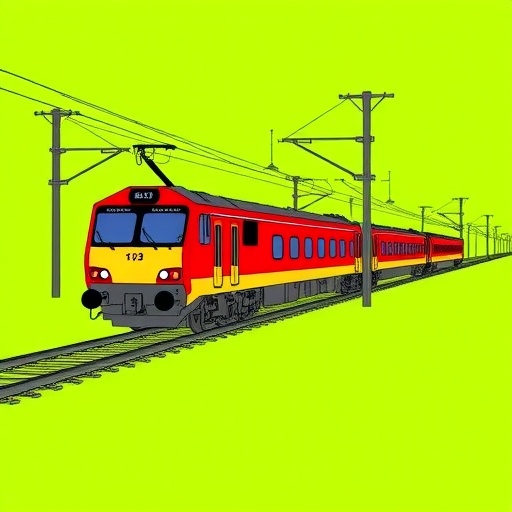In an era increasingly defined by technological advancements, the transportation sector stands at the forefront of innovation. With the journey from one point to another becoming more efficient, safe, and automated, the integration of advanced artificial intelligence (AI) algorithms has revolutionized operations within the railway industry, particularly in shunting processes. The focal point of recent research is an automatic search model designed to optimize railway shunting routes. This model is grounded in an improved artificial neural network algorithm developed by researchers Li, He, and Yang. Their work showcases the potential for AI to transform traditional systems, thereby enhancing efficiency and safety in railway logistics.
Shunting, the process of transferring rail vehicles from one track to another, plays a critical role in railway operations. It is a multifaceted task involving the coordination of multiple trains, tracks, and timing schedules. Inefficiencies in shunting can lead to significant delays, impacting overall transportation systems. Recognizing these challenges, the authors embarked on a mission to harness AI as a means of optimizing and automating this key operational component.
The approach undertaken by the researchers revolves around the development of an automatic search model specifically tailored for railway shunting routes. By utilizing an improved artificial neural network (ANN) algorithm, they aimed to not only streamline the shunting process but also to enhance predictive capabilities for different train configurations and track layouts. This innovation seeks to balance complex variables such as train load, speed, and destination, providing a comprehensive solution that adapts to real-time conditions.
Central to this research is the architecture of the artificial neural network. The modified ANN offers enhanced processing capabilities compared to traditional models. It leverages layers of interconnected neurons that simulate human brain functionality, enabling it to learn from vast data inputs. As the model processes historical data regarding shunting operations, it improves its predictive accuracy and adapts to various operational scenarios, such as disruptions caused by weather or technical failures.
Moreover, the researchers highlighted the significance of training the neural network with extensive datasets collected from real-world railway systems. By incorporating diverse shunting scenarios and operational conditions into the training process, the model becomes more resilient and reliable. It gauges the interplay of distinct factors that impact shunting, including track switching times, train velocities, and inter-train distances, ultimately yielding optimized routing suggestions that enhance operational efficiency.
One of the most notable breakthroughs of this study is the model’s capability to predict optimal shunting routes with minimal computational time. In a typical railway environment, time is crucial; delays in shunting can cascade through operations, leading to further setbacks. The new ANN model’s efficiency allows it to generate optimal routes almost instantaneously, providing operational teams with actionable insights that can be implemented without extensive downtime. This rapid response capability is essential in maintaining schedules and minimizing disruptions to service.
The impact of this research extends beyond operational efficiency. By employing an automated model to manage shunting processes, railways can significantly reduce human error, a common factor in operational mishaps. Automation provides a layer of safety where decision-making is based on data-driven insights rather than human judgment, contributing to overall system reliability. This is particularly pertinent in high-pressure contexts, where the margin for error is slim.
As this model is implemented within railway operations, the potential for scalability becomes apparent. The researchers assert that the principles behind the automatic search model can be adapted for various transportation infrastructures beyond railways, including logistics in freight operations and even urban transit systems. The modular nature of AI algorithms means they can be reconfigured to address specific challenges unique to different transportation modalities, marking a new frontier in intelligent transport systems.
Additionally, the findings of this research underscore the broader implications of AI in public transport sustainability. An optimized shunting process not only enhances efficiency but also contributes to ecological initiatives by lowering energy consumption and reducing carbon footprints associated with rail operations. With greater predictability and reliability, railways can encourage customers to utilize public transport, which is often more sustainable compared to individual vehicle use.
This pioneering study and its findings represent a significant leap forward in how we approach rail shunting operations. It emphasizes the necessity for continuous integration of advanced technological solutions in industries traditionally reliant on manual processes. The automatic search model offers a glimpse into a future where technology seamlessly intertwines with transportation, paving the way for advancements that could revolutionize not just rail systems but multiple facets of logistics and mobility.
As we continue to navigate the challenges posed by growing urban populations and the expanding need for efficient transportation solutions, studies like this will play a pivotal role. They provide essential frameworks that can be utilized not just within the context of railways, but across various modes of transport and logistics networks. This canonical work is a testament to the innovative spirit of current research, showcasing how AI has the potential to transform operational practices for decades to come.
In conclusion, the automatic search model of railway shunting routes based on an improved artificial neural network algorithm signifies a monumental step forward in transportation efficiency. It bridges the gap between traditional practices and agile, responsive systems driven by data. As railway operators continue to adapt and evolve, the application of such advanced technologies will undoubtedly streamline operations and enhance service reliability, ensuring that railways remain a viable and effective transportation option in our ever-changing world.
Subject of Research: Automatic search model of railway shunting route optimization
Article Title: Automatic search model of railway shunting route based on improved artificial neural network algorithm
Article References:
Li, X., He, H., Yang, Y. et al. Automatic search model of railway shunting route based on improved artificial neural network algorithm.
Discov Artif Intell 5, 231 (2025). https://doi.org/10.1007/s44163-025-00484-6
Image Credits: AI Generated
DOI: 10.1007/s44163-025-00484-6
Keywords: AI, railway operations, shunting, artificial neural networks, transportation optimization, operational efficiency.




